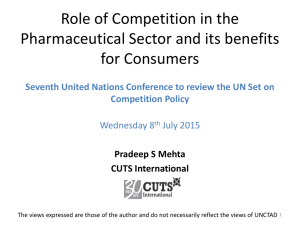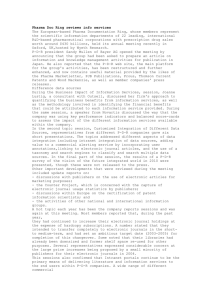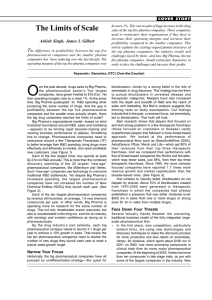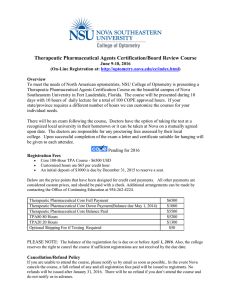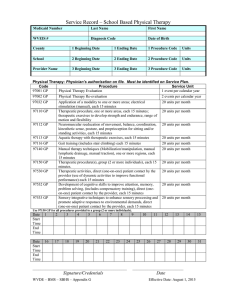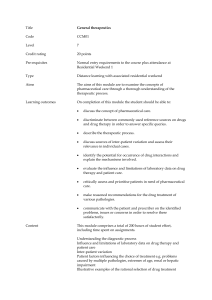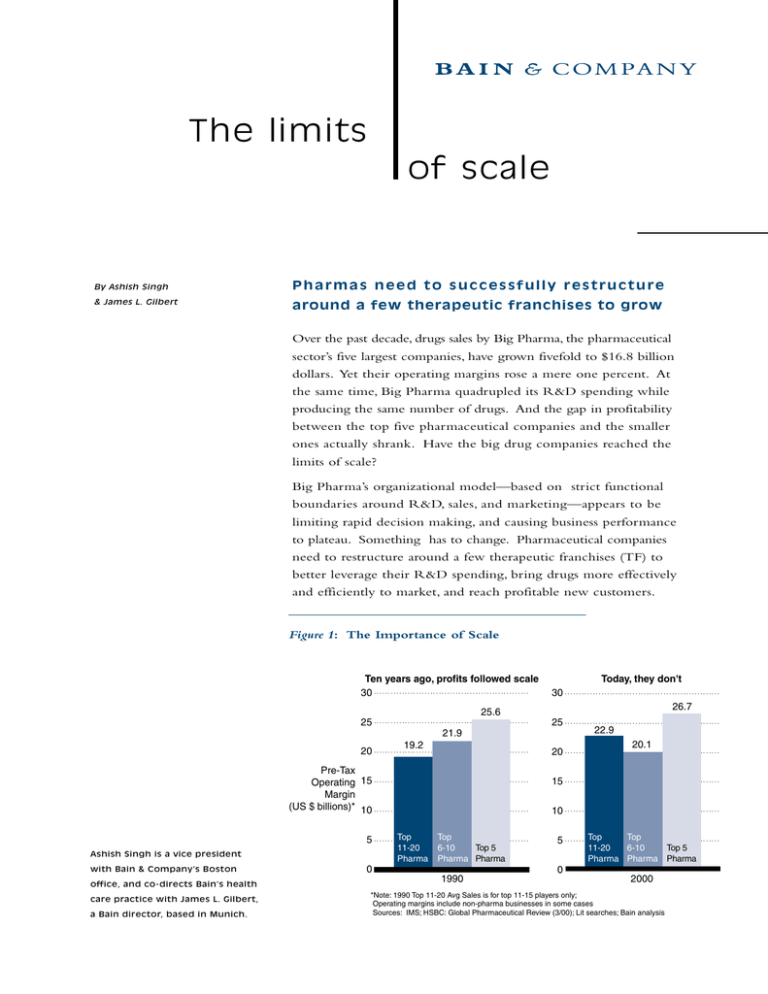
The limits
of scale
By Ashish Singh
Pharmas need to successfully restructure
& James L. Gilbert
around a few therapeutic franchises to grow
Over the past decade, drugs sales by Big Pharma, the pharmaceutical
sector’s five largest companies, have grown fivefold to $16.8 billion
dollars. Yet their operating margins rose a mere one percent. At
the same time, Big Pharma quadrupled its R&D spending while
producing the same number of drugs. And the gap in profitability
between the top five pharmaceutical companies and the smaller
ones actually shrank. Have the big drug companies reached the
limits of scale?
Big Pharma’s organizational model—based on strict functional
boundaries around R&D, sales, and marketing—appears to be
limiting rapid decision making, and causing business performance
to plateau. Something has to change. Pharmaceutical companies
need to restructure around a few therapeutic franchises (TF) to
better leverage their R&D spending, bring drugs more effectively
and efficiently to market, and reach profitable new customers.
Figure 1: The Importance of Scale
Ten years ago, profits followed scale
30
Today, they don't
30
26.7
25.6
25
25
21.9
20
19.2
20
Pre-Tax
Operating 15
Margin
(US $ billions)* 10
5
Ashish Singh is a vice president
with Bain & Company’s Boston
office, and co-directs Bain’s health
care practice with James L. Gilbert,
a Bain director, based in Munich.
22.9
20.1
15
10
Top
11-20
Pharma
Top
6-10
Top 5
Pharma Pharma
0
5
Top
Top
11-20
6-10
Top 5
Pharma Pharma Pharma
0
1990
2000
*Note: 1990 Top 11-20 Avg Sales is for top 11-15 players only;
Operating margins include non-pharma businesses in some cases
Sources: IMS; HSBC: Global Pharmaceutical Review (3/00); Lit searches; Bain analysis
Each of the five largest firms now spends at least
By the drug industry’s own estimate, each big phar-
$2.2 billion on R&D annually. This is more than
maceutical company needs to launch 3.1 drugs
the combined discovery spending of the 20
per year to achieve a 10% growth in sales. That
largest “new-age” pharmaceutical companies, like
means the top 10 pharmaceutical companies need
Millennium and Vertex. Such “new-age” companies
use technology to overcome traditional R&D
bottlenecks. Yet despite Big Pharma’s increased
spending, the largest pharmaceutical companies
have not increased the number of new chemical
entities (NCEs) they launch each year. (See Figure 2)
to double the number of new drugs they launch
each year to meet a typical sales-growth target.
Narrow your focus
Historically, the big pharmaceutical companies have
all pursued an undifferentiated strategy—the quest
Each of the 10 largest pharmaceutical companies
for blockbusters—driven by a strong belief in the
by revenue still launches, on average, 1.6 new
role of serendipity in drug discovery. This strategy
chemical compounds per year. In other words, Big
has led them to pursue blockbusters in unrelated
Pharma is spending more on research for the same
disease and therapeutic categories. Mergers
number of drugs. This not only misallocates scarce
have also increased both the depth and breadth
resources, but also is unsustainable in the long run,
of R&D and the reach of sales and marketing.
even for an industry with earnings and investor
But Bain’s analysis suggests this thinking rests on
confidence as strong as in pharmaceuticals.
faulty assumptions. Our findings indicate that in
the past, a narrower focus, not serendipity, led to
blockbusters. That truth will hold.
Figure 2: Pharmaceutical industry spends more
on R&D but produces fewer NCEs
80
$30B
$26.5B
70
$25B
60
57
NCEs
launched
$20B
50
40
$15B
36
30
$10B
Global
R&D
spending*
20
$6.5B
$5B
10
0
0
1988
1989
1990
1991
1992
1993
1994
1995
1996
1997
1998
1999 2000E
*Note: Annual Global R&D Spending by Research-based Ethical Pharmaceutical Companies
Sources: Datamonitor 1999; Annual PhRMA Survey 2000; Parexel's 2000 R&D Statistical Sourcebook; Analyst Reports; Tufts University
Attrition Rate Study; Juergen Drews “Innovation Gap” Study
B a i n & C o m p a n y, I n c .
The limits of scale
2
Bain research shows that players that focused on
And contrary to industry belief, blockbusters do not
and built strong positions in a few therapeutic
happen by chance. About 70% of blockbusters created
franchises (those focused on customers or disease)
from 1970—2000 were generated in therapeutic
vastly outperformed players that followed a more
franchises in which the companies had already
broad-based approach. We looked at the performance
established a presence that was either moderate
of pharmaceutical firms such as GlaxoSmithKline
(GSK), AstraZeneca, Pfizer, Merck, and Lilly—
which get 80% of their revenues from their top
(over $500M in sales from one or more drugs) or
strong (over $1B in sales from multiple drugs).
Face down four threats
three therapeutic franchises. And we compared
Several industry trends threaten the prevailing,
their performance with that of broad-based compa-
traditional business model of the fully integrated,
nies like Roche and Novartis, which reap fewer
large-scale pharmaceutical firm.
sales, just 58%, from their top three therapeutic franchises. Since 1990, the more narrowly focused
1
In the first place, new competitors, particularly
biotech firms, are using new technologies and
companies have reported 1.7 times more revenue
discovery techniques to make the discovery
growth and market capitalization than the broader-
process far more productive and less reliant on
based ones. (See Figure 3)
serendipity. Vertex, for instance, which spent
about $150 million in 2001 on R&D, has
more promising compounds in clinical trials
Figure 3: Pharmas with a narrow focus
have higher relative market share
in the same therapeutic franchise...
than do many major pharmaceutical companies.
At the beginning of 2002,Vertex had more
than 10 compounds in late stage trials, at par
with some of the largest companies in the
2
industry. New ways of discovering and testing
GSK
drugs—such as high-throughput screening
AstraZeneca
Schering-Plough
J&J
Relative
market share 1
within TFs*
Roche
Pharmacia
Wyeth
BMS
Bayer
Aventis
Abbott
Novartis
entry, making it easier for smaller companies
to compete against the big pharmas.
Lilly
0
Broad
and genomics—are reducing the barriers to
Pfizer/WLA
Merck
Narrow
...and they grow revenues and market cap faster
2
Some of the new technologies are also
challenging Big Pharma’s one-size-fits-all
approach to drug sales. Historically, the large
companies have used their broad-reaching
distribution networks to sell the same brand
of drug to every consumer with the same
Percent of
revenues from
top three TFs
58%
Average annual
growth rates
9%
15%
Market-cap
multiplier**
4.4x
7.6x
Broad
Narrow
80%
condition. But many think the emergence
of pharmacogenetics (and related technologies
Source: Bain & Company
Notes: * For the market leader, relative market share is defined as the ratio of
units or revenues compared to those of the #2 player. For market
followers, it is the ratio of their output compared to that of the leader.
like pharmacogenomics and pharmacoproteomics)
holds out the promise of custom drugs for
specific genetic profiles. One example is
Genentech’s new drug Herceptin, used
to treat aggressive breast cancer. It targets
HER2, a growth-factor receptor protein
** The number of times that market capitalization rose between
1990 and 2000.
B a i n & C o m p a n y, I n c .
The limits of scale
3
3
overproduced in 25-30% of patients with breast
The growing number of narrowly targeted drugs
cancer. The new drug is credited with increasing
and the increasing role of consumers in choosing
by 25% the chances of surviving aggressive
their drugs will inevitably change Big Pharma.
breast cancer, although it has also caused a
Licensing deals, co-promotions, partnerships,
handful of fatal hypersensitivity reactions.
bundling—many of the development and marketing
Traditionally, Big Pharma viewed pharma-
new to Big Pharma—are likely to become standard
cogenomics with suspicion. Executives
practice. At the same time, growing market complexity
believed that genotyped drugs would increase
will lead corporate strategists to take a portfolio
costs while decreasing revenues, because each
approach to their products. They’ll begin viewing
drug would serve a narrower market. But we
their business as satisfying a number of closely
believe the new drugs will actually increase
watched market segments, not creating individual
the industry’s long-range profitability. There
blockbuster drugs.
will be a short-term negative impact on the
Given these issues, it’s time for Big Pharma
cash flows generated by an average drug as a
companies to reevaluate their common business
result of higher attrition rates in early trials—
model—the fully integrated, research-led, functional
driven by greater yields in the pre-clinical
organizational structure—and find a new basis for
phase. However, long-term profits should be
competition. Many ways exist to create organizational
higher: These new, more targeted compounds
focus and accountability. One of Big Pharma’s
will benefit R&D by decreasing attrition
most viable options is to create business units
rates in ongoing trials and providing second
chances for drugs that caused adverse reactions in limited populations during clinical
4
tools common in other industries, but still relatively
around selected therapeutic franchises, focused on
customers or disease, where the company has
historical or emerging strength.
trials. Sales will benefit too. Better drugs
Redraw the org chart
will mean happier, more loyal customers,
Transforming a fully integrated, research-driven
and loyal customers are more likely to refill
firm into a more narrowly focused organization
their prescriptions.
requires fundamental structural change. Big Pharma
Another challenge to the distribution network
comes from more knowledgeable consumers.
Although doctors remain the primary targets
of gigantic drug-company salesforces, rising
drug costs and fixed levels of managed care
companies typically are organized around traditional
business functions, such as R&D, sales, and global
marketing. Apart from the chief executive and
the chief operating officer, no one is responsible
for the profit and loss of any individual therapeutic
franchises. If the company invests hundreds of
reimbursement are turning once-passive patients
millions of dollars in an immunology drug that fails
into price-sensitive consumers. Today, consumers
in the marketplace, no one—apart from the top
often choose generic over brand-name drugs.
officers—is held accountable. Little wonder that
Some of the most educated consumers even
pharmaceutical companies, historically unsuccessful
ask for formulary products if the generic is
in grooming strong general managers, have had
unavailable. Today’s consumers are also less
their entrepreneurial management talent eroded in
likely to simply take their doctor’s word
R&D, sales, and marketing. New-age pharmas like
about their health: According to one survey,
Vertex Phar maceuticals and bio-phar mas like
45% of Internet users read up on health issues.
B a i n & C o m p a n y, I n c .
The limits of scale
Amgen and Genentech lure away top performers.
4
The organizational structure of medical device
into an independent agency and converting its
companies provides a sharp contrast to Big Pharma’s
development, marketing, and sales functions into
approach. Medical device companies operate in
business units based on the firm’s therapeutic
highly segmented markets with relatively short-
franchises. This reorganization would effectively
lived products that must be quickly replaced with
decouple the traditional pharma value chain, with
new models. Such companies tend to be organized
profound implications for both the science and
around fully integrated business units focused on
the commercial organizations. Big Pharma should
customers or technology. For example, Medtronic’s
consider three key steps in reorganizing. (See Figure 4)
25,000 employees are organized in four primary
First,
product line groups—cardiac rhythm management,
vascular, cardiac surgery, and spinal—each with its own
global, product-line profit and loss statements (P & L).
Of course, there are many ways to create a differentiated strategy. The key is first to understand which
companies can set up business units based on
therapeutic franchises. Today, Big Pharma ascribes
the lion’s share of value creation to its commercial
or customer-related functions, and it discounts
the value of discovered compounds based on the
probability of their success. Yet commercial func-
core competencies set a firm apart from its com-
tions are inefficient when dealing with the com-
petitors, then to build a unique offering from such
plexity inherent in drug development, customers,
strength, wherever on the value chain it resides.
and global business management. One way to
Many drug companies’ strengths lie in specific
therapeutic franchises. Big Pharma companies have
better allocate value creation is to integrate the
the opportunity to reconstruct their organizations.
commercial with the development functions into
A company can start by turning its discovery arm
business units based on therapeutic franchises.
Figure 4: Rebuilding the business around
therapeutic franchises
Traditional
Entrepreneurial
3rd Party
Discovery
3rd Party
Discovery
Buy & Sell
NCEs
In-licensing
Global Therapeutic
Franchise 1
Research &
Development
(Chief Scientist)
Internal
Contracts
US
Sales &
Distribution
Asia
Sales &
Distribution
TF 2
TF 3
TF 4
-Clinical development
-Marketing
-Sales & Distribution
-Global P&L
Research &
Development
Europe
Sales &
Distribution
External
Sales
3rd Party
Pharma Co.
Source: Bain & Company
B a i n & C o m p a n y, I n c .
The limits of scale
5
Each therapeutic franchise would be responsible for
pushing their products forward. There’s no coun-
its own clinical development, sales, and marketing.
tervailing body with the knowledge to challenge
Each would control global profit and loss and
a team’s assertions, and no team stays in place
own a dedicated sales force. Each TF also would
long enough to remain accountable if its recom-
be free to obtain promising compounds from
mendation fails its promise. At the typical Big
outside firms or from the company’s own research
Pharma, decisions to invest in drugs are passed from
division. A general manager would run each
decision point to decision point without much
therapeutic franchise—and would be entirely
strategic rigor. Alternatively, a senior cross-functional
accountable for its financial results.
team overseeing all TFs should decide on key tradeoffs
Second,
companies need to separate R from D.
Companies should carve out Research (scientific,
—what to do with new compounds, which TF
to focus on, and which TF to exit.
through early drug discovery) into autonomous
The Portfolio Management Team’s role should
organizations that deal at arm’s length with the
be threefold:
company’s business units and are run by a general
manager with a blended profit and loss. An independent research division such as this would
give the pharmaceutical parent several advantages.
It would bring together critical technologies
scattered around the organization, such as highthroughput screening, combinatorial/computational
• to push the TFs to defend their
compound decisions;
• to make cross-TF resource
allocation decisions;
• to decide which TFs to initiate investment in,
increase investment in, disinvest, or exit.
chemistry, or genomics. This would allow the
company to fully realize the true benefits of scale
Reap fivefold returns
—not size—and grow bigger in specific strategic
Organizational change bears a high cost in employee
areas. It would also increase accountability and
time, concentration, asset utilization, and cash
entrepreneurship. Current scientific trends, such
resources, but the payoff should more than repay
as genomics and high-throughput discovery, would
the investment. We calculated the full potential of
probably facilitate the shift to an independent dis-
reorganizing the business around a few carefully
covery organization, although it will likely be some
chosen therapeutic franchises. The net present
time before any parent company sees a payback.
value, or the incremental cash a company could
Still, this independent research unit could increase its
have today from the lifelong proceeds of a successful
“option” value in the event the parent decides to spin
drug, could be nearly five times higher for a
it off, or at least partially float it in a public offering.
company with therapeutic franchise business units
And third,
Big Pharma companies should start
rigorously managing their portfolios of drugs.
At present, most do not have formal portfolio
management systems, with Merck and Eli Lilly
the rare exceptions. Rather, project teams come
than for the typical broadly focused Big Pharma
company. That could translate into between $2B
and $3.5B of incremental cash over the life of a
blockbuster drug. The extra value emerges at
several stages.
together ad hoc and disband after a product
First of all, value comes from an increase in R&D
launch, which means no team remains accountable
productivity. A pharmaceutical company with an
for results. More often than not, compounds
independent research division and highly focused
reviewed meet threshold criteria for commercial
therapeutic franchises for drug development,
launch because reviewers have self-interest in
marketing, and sales can expect to launch 2.8
B a i n & C o m p a n y, I n c .
The limits of scale
6
new compounds per year, compared with 1.6
is promoting entrepreneurship and a narrower
new compounds for the conventional company.
focus. It has announced a radical restructuring
The former launches will cost less because
of its R&D to take advantage of scale. Glaxo is
focused trials will lead to faster discovery
setting up six “centers of excellence for drug dis-
and have a higher probability of success.
covery” that will be responsible for early discovery
In addition, if the therapeutic franchises are truly
center, the company says, will be autonomous,
entrepreneurial, they will license new compounds
from outsiders. This, too, will increase the number
of compounds, hasten development, and increase the
chances of success. For example, Merck successfully
licensed its anti-hypertensive cardiovascular offerings,
Cozaar and Hyzaar, from DuPont Pharma. Because
Merck has such a strong cardiovascular franchise, it
became the logical partner for DuPont, a relatively
small player in the pharma business. Moreover, a
company organized around therapeutic franchises
will be able to more quickly reach full-potential
market penetration and hence enjoy a higher
and early clinical development of new drugs. Each
accountable, and entrepreneurial along the
lines of a biotech company. By this standard,
Glaxo needs to migrate its quest for focus to
the development half of R&D, and then on to
its commercial functions.
AstraZeneca also has tried a new approach
by creating a centralized sales and marketing
infrastructure in hopes of turning the merger of
two, midsize, European companies into a global
power. The new structure revolves around a
product strategy and licensing unit, which will
market share and a longer peak sales period.
form the bridge between R&D, and sales and
Third, business units organized around therapeutic
unit will manage the company’s product portfolio
franchises will also be better positioned to effectively manage
a drug’s lifecycle. For example, before a drug’s patent
expires, such units can plan what to do with it—
whether, for instance, to build the brand as an over-
marketing. Comprising three divisions, the new
and prepare the company and the market for the
launch of new products. Next,AstraZeneca should
apply this approach to its R&D operations.
the-counter drug or launch a strong generic strategy.
Companies have plenty of options, of course,
Finally, therapy-based business units can more easily
itself—its strategic position and its organizational
target new products that address medical problems
related to their therapeutic franchises. For instance,
and the best options will depend on the company
and technical capabilities.
the manager of a business unit devoted to diabetes
Manage down risks
could also target heart disease, a common killer of
Some executives say that a focus on therapeutic
diabetic patients. A TF general manager could
franchises is like putting all their eggs in one basket.
likewise look for new profit streams—for example,
What if one company chooses to specialize in
diagnostics and devices needed for his therapeutic
immunology and another company’s drug comes
franchise, such as new insulin delivery systems
along and takes that market? While this concern is
for diabetics.
understandable, concentration on a few therapeutic
Leading pharmaceutical companies continue to
franchises may well be the less risky option. That’s
pursue blockbuster-type strategies. However,
several players have started to experiment with
alternative models such as limited therapeutic
franchises, multiple product focus within the
franchise, and global brand management. These
are good first steps, but they fall short of an
integrated solution. For instance, GlaxoSmithKline
B a i n & C o m p a n y, I n c .
The limits of scale
because potential competitors are less likely to
be attracted to an area in which another company
has demonstrated leadership. And it’s because the
best response to another company introducing
a better drug is licensing, co-promotions, and
joint ventures—not spreading corporate resources
too thinly.
7
Another key concern is the failure to spot attractive
What can you do Monday morning, 8 o’clock?
opportunities in new TFs, which fall outside a
• Assess how to turn your discovery business
tight focus on existing TFs.
into an independent operation, either within
Our answer? Internal management processes
the company or spun off as a separate entity.
have to change, or be created, to minimize any
Consider establishing a research organization,
concentration of risk or potential for missed
run by a general manager, which would own its
opportunities. Establishing processes like rigorous
own P & L and serve all therapeutic franchises.
portfolio management and regular reviews across
• Begin identifying your select franchises that
therapeutic franchises and research investment
could be reorganized as independent, integrated
portfolios should help. This will facilitate directing,
units. Start looking for a general manager
or redirecting, investments to attractive areas—
who could direct each one and be accountable
including establishing new TFs and exiting from
for the TFs’ own P & L from development
less attractive ones.
to global sales and distribution.
In truth, maintaining Big Pharma’s current,
• Start setting up a cross-functional, senior
undifferentiated approach may prove to be at least
committee to manage the company-wide
as risky as the path we suggest. The strategy of
portfolio of all the therapeutic franchises
growing scale to better pursue blockbusters has
plus research, evaluating which compounds
topped out. It doesn’t work in the current business
to promote, which franchises to promote,
environment. Big Pharma will have to adopt a
and where to phase out or start anew.
business strategy that does work, a differentiated,
focused strategy.
BAIN & COMPANY, INC.
Further reading
Corporate Headquarters
Two Copley Place
Weakest links in the supply chain
Financial Times by Miles Cook and Nick Jackson
Boston, Massachusetts 02116 USA
1 (617) 572 2000
Debunking layoff myths
www.bain.com
Bain Strategy Brief by Darrell Rigby
Rip the Band-Aid off quickly
Bain Strategy Brief by Stan Pace
Amsterdam
Milan
•
•
Atlanta
Munich
•
•
Beijing
New York
•
•
Boston
Paris
•
•
Brussels
Rome
•
•
Chicago
San Francisco
Copyright © 2002 Bain & Company, Inc. All rights reserved.
•
•
Dallas
•
São Paulo
Hong Kong
•
Seoul
•
•
Johannesburg
Singapore
•
•
London
Stockholm
•
•
Los Angeles
Sydney
•
Tokyo
•
•
Madrid
Toronto
Mexico City
•
•
Zurich


